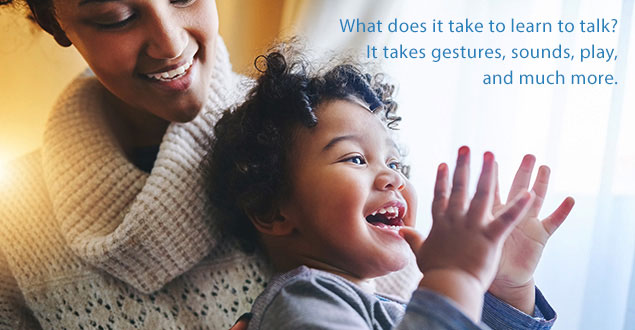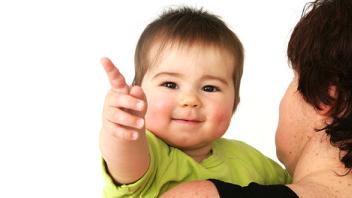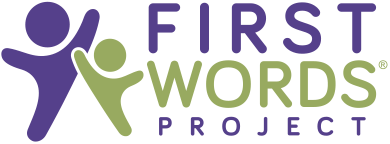
Introduction
Good communication development starts in the first year of life and goes far beyond learning how to talk. Communication development has its roots in social interaction with parents and other caregivers during everyday activities.
Your child’s growth in social communication is important because it helps your child connect with you, learn language and play concepts, and sets the stage for learning to read and future success in school. Good communication skills are the best tool to prevent behavior problems and make it easier to handle moments of frustration that all infants and toddlers face. Learn more:
Communication milestones: 1–24 months
Did you know that a baby’s brain is developing the most rapidly during the first two years of life? These early years offer a critical window of opportunity, like no other time, to launch language early and get a jump start on school success. Learn the milestones that develop from 1–24 months. Select your child’s age:
A critical time: 9 to 16 months
- Screen My Child (FIRST WORDS® Project)
- Social Communication Growth Charts (FIRST WORDS® Project)
The richest moments for early language learning are when a child and caregiver share attention on the same thing and the caregiver talks about the child’s focus of attention. This creates opportunities to learn that stem from actions with objects … and gestures. By observing early actions with objects and gestures between 9 and 16 months, you can get a critical snapshot of what a child knows and is thinking about.
If a child is not using a variety of actions with objects and gestures from 9 to 16 months, then the parent may not have the chance to respond and follow the child’s focus. This limits the child’s opportunity for the richest moments to learn to talk. Spotting small gaps in early actions with objects and gestures from 9 to 16 months is the best time to get ready for preschool so children can reach their potential by kindergarten.
Key social communication milestones develop between 9 and 16 months and they provide the foundation needed to launch language and learning:
- use eye gaze and facial expression to share emotion — both enjoyment/interest and frustration/distress
- use eye gaze and communication to share attention, interests, and ideas
- communicate at an increasing rate with gestures, sounds, and a few words sprinkled here and there
- use a variety of actions with objects in play and other everyday activities
- understand the meaning of spoken words
If these early social communication milestones are not solidly in place, it is likely that a child will be delayed in learning to talk. It is important to keep in mind that delays in these social communication milestones may indicate risk for developmental delays, including autism.
By detecting small gaps in early social communication skills, you can get extra help to support your child’s development before significant delays are evident.
What should a child be able to do at 16 months?
The First Words Project developed the 16by16TM series to help families and others learn the critical social communication skills that children should reach by 16 months in order to launch language learning, literacy, anmd much more by 24 months. The guides illustrate what to look for, using photographs and milestone markers for each month during the 9-16 month span:
- Language Learning: 16 Gestures by 16 Months
- Imagination: 16 Actions with Objects by 16 Months
Additional 16by16TM guides (social connectedness, managing emotions, and messages to understand) are under development.
Delays in communication and language development
Delays in communication and language development are often the first sign of developmental problems in young children. Families with concerns should seek intervention as soon as possible. Early diagnosis and treatment for developmental delays increases the chances of improvement rather than simply “waiting it out” and treating problems later.
Earlier is better
Treating communication and language difficulties early on can prevent potential problems with behavior, learning, reading and social interaction. Recent research on brain development reminds us that “earlier IS better” when teaching young children. By age 3, most of the major brain structures are mature, and it becomes more difficult to make significant changes in a child’s growth and development. Learn more:
Delays in communication and Autism Spectrum Disorder (ASD)
Browse these information sheets developed by Autism Navigator and Florida State University:
- Critical Information for Parents of Young Children with Social Communication Delays
- What Is Autism Spectrum Disorder?
- Red Flags of ASD in Toddlers
To find out what support services are offered in your state, visit the Early Childhood Technical Assistance Center .
FIRST WORDS® Project is a longitudinal research investigation in the Florida State University Autism Institute, directed by Dr. Amy Wetherby. Our goal is to identify early signs of communication delays in young children by improving screening tools and helping families support child development. Copyright © 2019 Florida State University. All rights reserved.

